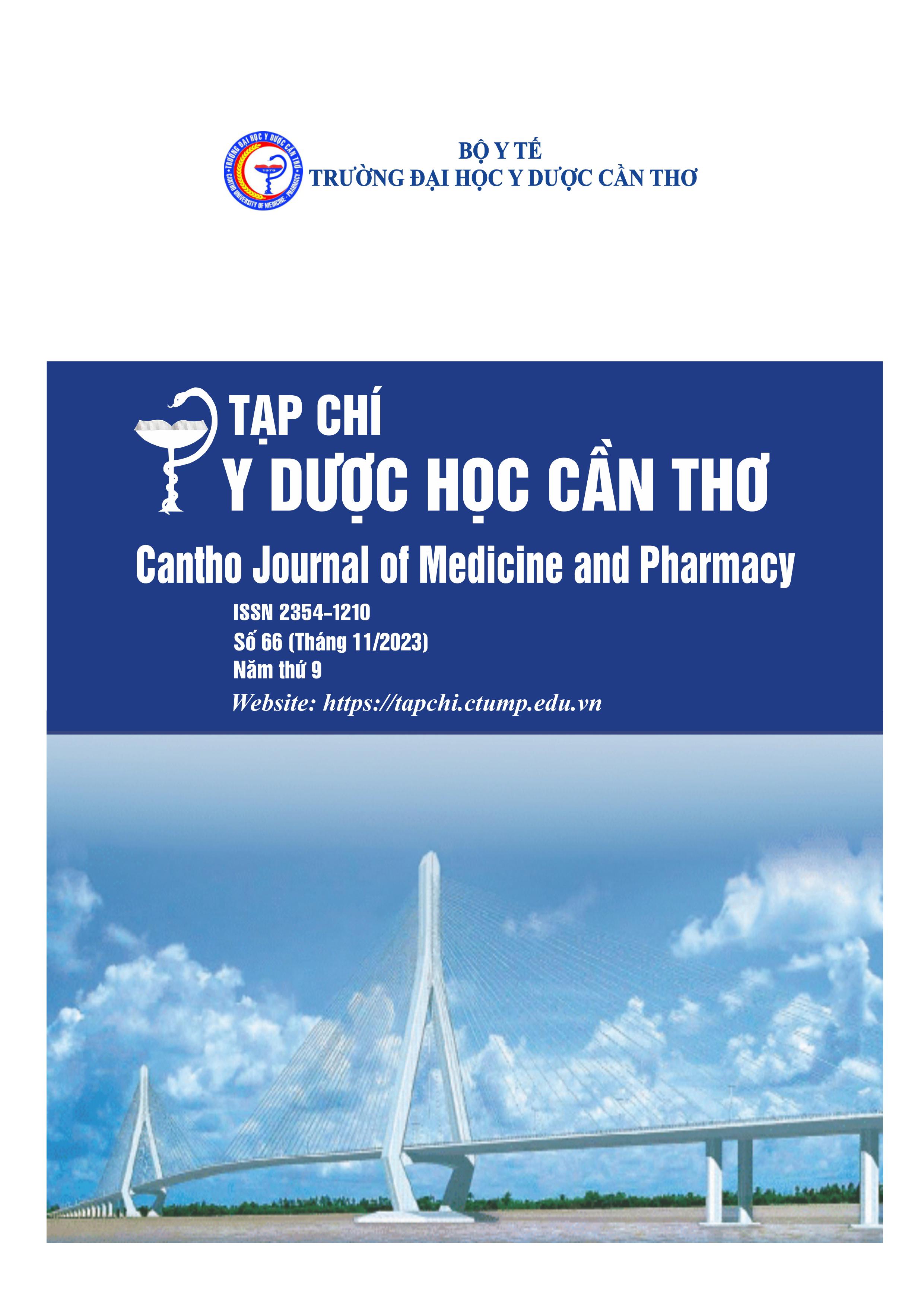STUDY ON THE CHARACTERISTICS OF KNEE OSTEOARTHRITIS IN PATIENTS WITH METABOLIC SYNDROME AGED 40 - 70 YEARS AT CAN THO CENTRAL GENERAL HOSPITAL IN 2022 - 2023
Main Article Content
Abstract
Background: The rate of knee osteoarthritis in patients over 40 years old with metabolic syndrome is increasing, people with metabolic syndrome have twice the risk of osteoarthritis of the knee compared to the normal person, early detection and treatment will help slow the process of osteoarthritis. Objectives: 1). To describe the characteristics of knee osteoarthritis in patients with metabolic syndrome from 40 to 70 years old; 2). To identify some factors related to the rate of knee osteoarthritis with components of metabolic syndrome and 3). Evaluation of results of treatment of knee osteoarthritis with diacerein. Materials and methods: Descriptive crosssectional design with analysis on 147 patients with knee osteoarthritis with metabolic syndrome aged 40-70 years at Can Tho Central General Hospital from July 2022 to June 2023. Results: The knee osteoarthritis patients with metabolic syndrome in male is 18.4%, female was 81.6%. The age of 40-49 was 12.2 %, the age of 50-59 was 31.2%, the age of 60-70% was 55.8%. Glucose, hypertension is related to knee osteoarthritis. Each month during three the month treatment, WAS pain score reduced 4.24±1.25, WOMAC score change 26.12±2.56, Improves function of the knee is including: The stretch is 46%, and the flex is 64%. Conclusions: Female is more knee osteoarthritis than the male, especially in the 60-70 age group. Glucose, hypertension is related to knee osteoarthritis. Diacerein can have decreased pain and improves the function of the knee osteoathritis effectively.
Article Details
Keywords
Knee osteoarthritis, Metabolic syndrome, Diacerein (ROHCEREIN)
References
2. Mora Juan C. Knee osteoarthritis: pathophysiology and current treatment modalities. J Pain Res, 2018, 2189-2196. doi: https://pubmed.ncbi.nlm.nih.gov/30323653/.
3. Puenpatom RA., Victor TW.. Increased Prevalence of Metabolic Syndrome in Individuals with Osteoarthritis: An Analysis of NHANES III Data. Postgraduate Medecine, 2009, 9-20. doi: https://pubmed.ncbi.nlm.nih.gov/19940413/.
4. Dahaghin S, Bierma Sm, et al. Do metabolic factor add to the effect of overweight on hand osteoarthritic? The Rotterdam Study. Ann Rheum Dis, 2007, 916-920. doi: https://www.ncbi.nlm.nih.gov/pmc/articles/PMC1955104/.
5. Nguyễn Thị Thanh Phượng. Nghiên cứu đặc điểm lâm sàng, cận lâm sàng, siêu âm và cộng hưởng từ khớp gối ở bệnh nhân thoái hóa khớp gối, Luận án tiến sĩ Y học, Trường Đại học Y Hà Nội. 2019.
6. Nguyễn Thị Thanh Mai. Khảo sát nồng độ IL-1β huyết tương ở bệnh nhân thoái hóa khớp gối nguyên phát mắc hội chứng chuyển hóa, Luận án tiến sĩ Y học, Trường Đại học Y Hà Nội. 2019.
7. Lê Na. Nhận xét tình trạng thoái hoá khớp gối ở người có hội chứng chuyển hoá từ 40 đến 70 tuổi tại khoa khám bệnh theo yêu cầu Bệnh viện Bạch Mai, Luận văn thạc sĩ Y học, Trường Đại học Y Hà Nội. 2012.
8. Trịnh Thị Nga. Nghiên cứu tác dụng của diacerein trong điều trị thoái hóa khớp gối ngyên phát, Luận văn thạc sĩ Y học, Trường Đại học Y Hà Nội. 2018.
9. Niu J, Clancy M, Aliabadi P., et al. Metabolic Syndrome, Its Components, and Knee Osteoarthritis: The Framingham Osteoarthritis Study. Arthritis&rheumatology, 2017, 69(6), 1194-1203. doi: https://pubmed.ncbi.nlm.nih.gov/28257604/.
10. Louthrenoo W., et al. The efficacy, safety and carry-over effect of diacerein in the treatment of painful knee osteoarthritis: a randomised, double-blind, CVKS-controlled study. OsteoArthritis and Cartilage, 2007, 15, 605-614. doi: https://pubmed.ncbi.nlm.nih.gov/17448700/.


